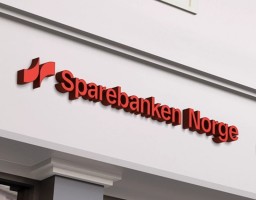Size matters as Sparebanken Norge plants debut €1bn flag
Sparebanken Norge sold its first euro benchmark covered bond on Wednesday, a €1bn five year that marked a step-up from predecessors Vest’s and Sør’s issuance and encountered commensurate greater investor interest, according to head of treasury John Hopp.
 Sparebanken Norge was created by the merger of Sparebanken Vest and Sparebanken Sør in May, and is now Norway’s largest savings bank and second largest bank. The covered bond issuers, and respective pools, of the two were also merged and are constitute Sparebanken Norge Boligkreditt, with a combined NOK202.4bn (EUR17.4bn) of covered bonds outstanding ahead of yesterday’s deal, 44% in Norwegian kroner, 46% in euros, and 6% in Swedish kronor.
Sparebanken Norge was created by the merger of Sparebanken Vest and Sparebanken Sør in May, and is now Norway’s largest savings bank and second largest bank. The covered bond issuers, and respective pools, of the two were also merged and are constitute Sparebanken Norge Boligkreditt, with a combined NOK202.4bn (EUR17.4bn) of covered bonds outstanding ahead of yesterday’s deal, 44% in Norwegian kroner, 46% in euros, and 6% in Swedish kronor.
“We are a little bit unique among Scandinavian names,” Hopp, head of treasury at Sparebanken Norge and CEO of Sparebanken Norge Boligkreditt, told The CBR. “We’re now the largest savings bank in Norway and the corporate structure of the bank is very low in complexity – we’re also not part of any alliance – and that is probably one of the larger selling factors.
“Of course, we have a good performance in terms of our earnings and financial performance,” he added, “and have established ourselves as a leader digitally in Norway. That, combined with a 200 year history as a savings bank, is a very simple story to tell to our investor base, which is primarily in the Nordics, Germany and elsewhere in core Europe.”
After completing the preparations for post-merger issuance, such as updating its EMTN documentation, Sparebanken Norge launched the first covered bond under the new name on 2 September, successfully doing so in its home market with a NOK8.5bn five year deal.
The last euro benchmark from either predecessor was a €750m June 2030 issue from Sparebanken Vest Boligkreditt in March. Whereas Vest issuance was €500m up to €750m in size, and Sør benchmarks €500m, the magnitude of the combined entity meant that €1bn was the new bar for Sparebanken Norge.
“A year ago when we announced the merger, we already started discussing what our financing would look like when it was complete,” said Hopp, “and we naturally did a lot of investor work, both virtually and physically, not least at the recent ECBC event in Seville. So we definitely did our best to prepare for it.
“But in spite of this, and even though we were a frequent issuer as Sparebanken Vest and Sparebanken Sør also had euro issues outstanding, when you change the name and come out with your first ambition to do €1bn, it can be a little nerve-wracking.”
However, with market conditions looking constructive in spite of the potential for geopolitical interference, and supply modest in recent weeks, the issuer sensed an attractive opportunity to proceed with its euro benchmark, with the mandate announced on Tuesday.
“We knew we would probably have a clear window, without too many other issuers, so people could focus on ours,” added Hopp (pictured), “and we always do a day-and-a-half process anyway, which gives investors time to prepare – those who we didn’t meet or maybe weren’t familiar with the story just had that extra afternoon and evening to check their credit line.
 “And the day before, the feedback was very positive, and then it looked like a very good day to go to the market.”
“And the day before, the feedback was very positive, and then it looked like a very good day to go to the market.”
On Wednesday morning, leads Crédit Agricole, Danske, Deutsche, Erste, HSBC, ING and UBS opened books with guidance of the mid-swaps plus 34bp area for the October 2030 euro benchmark, expected rating Aaa. After around an hour and 10 minutes, they reported books above €2.5bn, including €425m of JLM interest, then after three hours the spread was set at 27bp and the size fixed at €1bn on the back of books above €3bn. The final order book was ultimately €2.6bn, with orders from 85 accounts. A banker at one of the leads put the new issue premium at zero.
“I was surprised at the size of the book – we got to over €3bn – which was very comforting,” said Hopp. “Obviously there are some fast money orders in that, but we felt that our initial price was generous, but not overly so. There’s always a lot of discussion around fair value for a new name, but we started at 34bp and the size and the strength of the book kept building, so even when we pushed 7bp down to 27bp, although we saw some drops, we also saw quality orders continuing to come in until the book was closed.
“Everything I hoped we could achieve with this deal, we did, in terms of planting the flag, showing that we can do a billion, having a strong and broad, quality book,” he added. “So we’re very happy with the trade and thankful to our investor base – it’s nice to see they showed up and will support the story after the merger and beyond.”
Indeed, the size of the bank and offering contributed to the success, according to Hopp.
“There are a lot of investors who, for liquidity purposes, prefer size, so coming with €1bn brought in not only new investors who typically want that kind of size, but also other accounts who have historically supported us felt more confident coming in for bigger tickets. What’s also important is that investors are now looking at us as the second largest Norwegian bank and largest savings bank.
“That combination was probably what helped us get to that €3bn mark.”
Banks and private banks were allocated 63%, asset and fund managers 30%, official institutions and central banks 5%, insurance companies and pension funds 2%. The Nordics took 34%, Germany 34%, Austria and Switzerland 11%, the Benelux 7%, the UK and Ireland 7%, France 6%, and other 1%.
Sparebanken Norge Boligkreditt plans to issue around four benchmarks annually henceforth, typically half in Norwegian kroner and half in euros.
“So two in each currency, spring and fall,” said Hopp. “It’s clear what our maturity profile looks like, and we have ambitious growth targets for the bank, so whereas our base case previously was €500m to €750m, as a bigger bank it will definitely be more a €750m-€1bn range – although that depends on just how growth, liquidity, etc develop.”
Benchmarks of €1bn would put Sparebanken Norge closer to DNB’s and SpareBank 1 Boligkreditt’s issuance, and Hopp said the issuer’s ambition is also to be among the tightest names in Norway and wider Scandinavia.
“I can’t control the market when it comes to final pricing,” he said, “but just manage the timing and process when we come to market, and do our investor work. Being a retail savings bank with a simple credit story, and given our strong numbers, I believe the credit case supports our ambition, but that’s something we’ll have to demonstrate over time.”
The issuer has outstanding green covered bonds in euros, Norwegian kroner and Swedish kronor issued by the two predecessors, and is working towards merging the two green frameworks, “using the best of the best”, noted Hopp.
“Our ambition is to be a leading bank in terms of ESG at Sparebanken Norge.”

